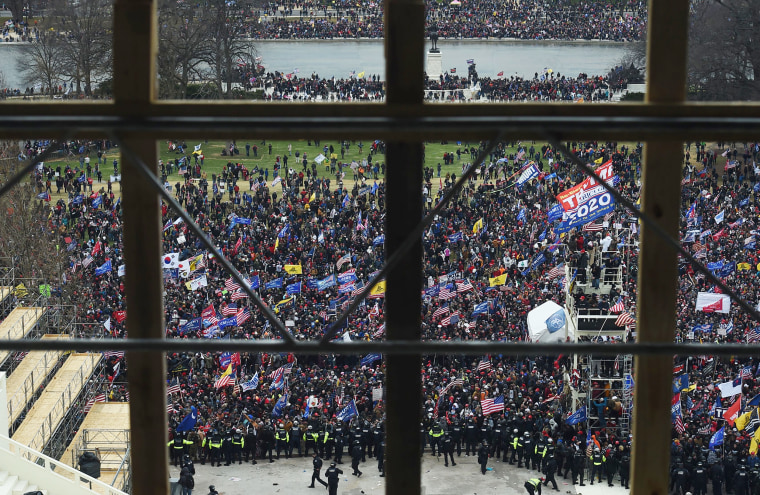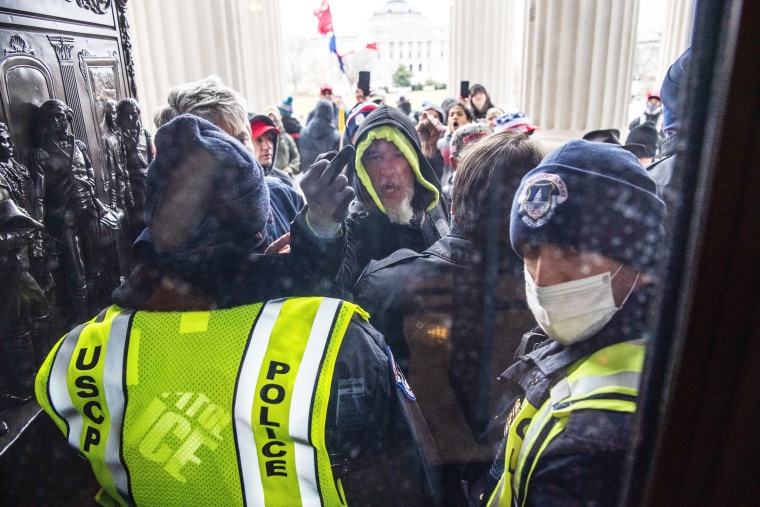Committee aides said there will be new information presented at the 8 p.m. ET hearing, some of it recently obtained by the special House panel.
The roughly two-hour hearing will be led by Reps. Elaine Luria, D-Va., and Adam Kinzinger, R-Ill. It will provide a “minute-by-minute” account of what was happening inside the West Wing and what Trump was doing during the 187 minutes, aides said. That’s the period from the end of Trump’s speech at the Ellipse at 1:10 p.m. to 4:17 p.m., when he tweeted a video telling rioters to “go home.”
Committee members on Thursday will build on details laid out in previous hearings. They will demonstrate, aides said, that Trump not only wanted to join his supporters at the Capitol after his speech Jan. 6, but he also continued expressing a desire to go there even after his security team told him it wasn’t safe and took him back to the White House.
The hearing will discuss Trump’s chief of staff, Mark Meadows, his family members, allies and GOP lawmakers.
The committee also will examine a 6:01 p.m. tweet by Trump that day that was deleted. He had suggested that the Capitol attack should be blamed on widespread election fraud.
“These are the things and events that happen when a sacred landslide election victory is so unceremoniously and viciously stripped away from great patriots who have been badly and unfairly treated for so long. Go home with love and in peace. Remember this day forever!” Trump wrote before deleting the tweet.

In another development, aides said Jan. 6 Committee Chairman Bennie Thompson, D-Miss., will lead the hearing “remotely” after testing positive earlier in the week for Covid. Committee members had said that they have the capability for Thompson to appear via video conference.
“He is feeling OK. He is vaccinated and boosted, but of course, we will observe Covid protocols,” an aide said.
The hearing will feature live testimony from a pair of former Trump White House aides, Sarah Matthews and Matthew Pottinger, who have already testified behind closed doors.
Both Matthews and Pottinger resigned over Trump’s actions Jan. 6, with Pottinger saying in testimony already aired by the committee that he was driven by Trump’s 2:24 p.m. tweet that day. In it, Trump wrote that his vice president lacked courage as a mob in the Capitol searched for him and chanted “Hang Mike Pence!”
“President Trump had the power to call off the mob. He was the sole person who could have called off the mob, and he chose not to,” an aide said.
The Jan. 6 panel plans to hold more hearings later this year.

Committee investigators had hoped to receive a tranche of text messages from the Secret Service this week that might have provided more details about Trump’s actions Jan. 6. Former White House aide Cassidy Hutchinson had told the committee that she was told Trump had tried to grab the steering wheel of his presidential SUV and got into a physical altercation with his top security official after he was told he was not going to the Capitol.
The Secret Service turned over more than 10,000 pages of documents to the Jan. 6 panel Tuesday but only a single text message related to the riot itself, according to a letter from the Secret Service to the committee. That message was from then-Capitol Police Chief Steven Sund to the Secret Service, asking for help.
The Secret Service told the committee that agents’ text messages Jan. 5 and 6, 2021, were deleted as part of a preplanned system migration. Employees were told how to preserve relevant texts and other data, but the Secret Service said it has no messages being sought by the committee or an agency watchdog.
Committee members are furious over the Secret Service’s explanation.
“We have concerns about a system migration that we have been told resulted in the erasure of Secret Service cell phone data. The U.S. Secret Service system migration process went forward on January 27, 2021, just three weeks after the attack on the Capitol in which the Vice President of the United States while under the protection of the Secret Service, was steps from a violent mob hunting for him,” Thompson and Vice Chair Liz Cheney, R-Wyo., wrote in a joint statement Wednesday.
The “procedure for preserving content prior to this purge appears to have been contrary to federal records retention requirements and may represent a possible violation of the Federal Records Act,” they said.
Ali Vitali and Haley Talbot contributed.
Source: | This article originally belongs to Nbcnews.com









